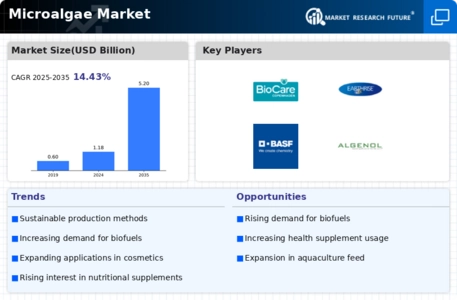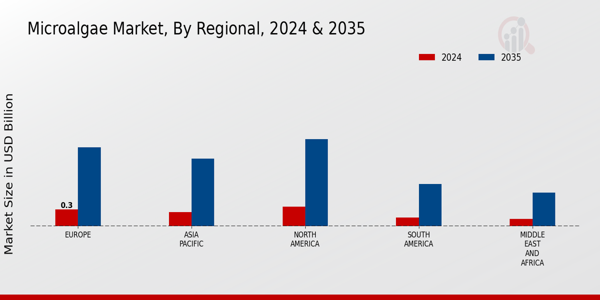Market Growth Projections
The Global Microalgae Market Industry is poised for substantial growth, with projections indicating a market size of 1.18 USD Billion in 2024 and an anticipated increase to 5.2 USD Billion by 2035. This growth trajectory is supported by a compound annual growth rate of 14.43% from 2025 to 2035. Such projections highlight the increasing recognition of microalgae as a valuable resource across various sectors, including food, pharmaceuticals, and cosmetics. The market's expansion reflects a broader trend towards sustainable and innovative solutions in response to global challenges, positioning microalgae as a key player in future industries.
Advancements in Biotechnology
Technological advancements in biotechnology significantly influence the Global Microalgae Market Industry. Innovations in genetic engineering and cultivation techniques enhance the efficiency and yield of microalgae production. For instance, the development of high-yield strains and optimized growth conditions allows for more sustainable harvesting methods. These advancements not only improve the economic viability of microalgae but also contribute to meeting the projected market growth to 5.2 USD Billion by 2035. As biotechnology continues to evolve, it may unlock new applications for microalgae in various sectors, including pharmaceuticals and biofuels.
Growing Awareness of Health Benefits
The Global Microalgae Market Industry benefits from increasing awareness of the health benefits associated with microalgae consumption. Rich in omega-3 fatty acids, antioxidants, and vitamins, microalgae are recognized for their potential to enhance overall health and well-being. This growing recognition is reflected in the rising incorporation of microalgae into dietary supplements and functional foods. As the market expands, it is likely to attract health-conscious consumers, contributing to a compound annual growth rate of 14.43% from 2025 to 2035. This trend indicates a promising future for microalgae as a health-promoting ingredient.
Diverse Applications Across Industries
The Global Microalgae Market Industry is characterized by its diverse applications across various sectors, including food, cosmetics, and biofuels. Microalgae are utilized in the production of dietary supplements, animal feed, and even biofuels, showcasing their versatility. This broad applicability not only enhances market potential but also attracts investments and research into microalgae-based products. As industries seek sustainable alternatives, the demand for microalgae is expected to rise, supporting the projected market growth to 5.2 USD Billion by 2035. This diversity in applications may play a crucial role in shaping the future landscape of the microalgae market.
Environmental Sustainability Initiatives
The Global Microalgae Market Industry is significantly influenced by environmental sustainability initiatives. Governments and organizations worldwide are increasingly promoting the use of microalgae as a sustainable alternative to conventional agricultural practices. Microalgae cultivation requires fewer resources, such as water and land, compared to traditional crops, making it an attractive option for sustainable development. As environmental regulations tighten and the focus on reducing greenhouse gas emissions intensifies, microalgae could emerge as a key player in achieving sustainability goals. This trend may further drive market growth and innovation in the coming years.
Rising Demand for Sustainable Food Sources
The Global Microalgae Market Industry experiences a notable surge in demand for sustainable food sources. As consumers increasingly prioritize health and environmental sustainability, microalgae, rich in proteins and essential nutrients, emerge as a viable alternative to traditional protein sources. The market is projected to reach 1.18 USD Billion in 2024, driven by the growing interest in plant-based diets and functional foods. This shift aligns with global efforts to reduce carbon footprints and enhance food security, suggesting that microalgae could play a pivotal role in future food systems.








Leave a Comment